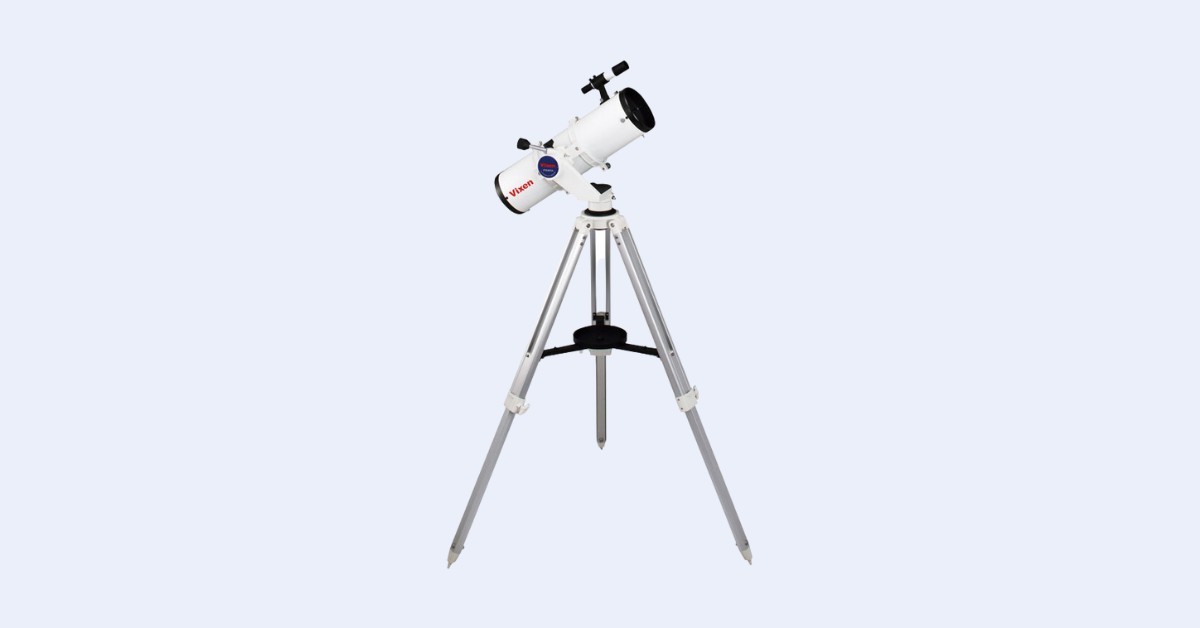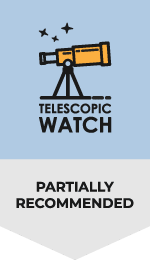The Optical Tube
The Vixen R130SF is a 130mm (5.1”) f/5 Newtonian reflector with a focal length of 650mm. Like most good-quality scopes of this size and specification, it features a parabolic primary mirror to form sharp images at the eyepiece. The R130SF optical tube is identical to the Zhumell Z130 in all mechanical and optical aspects and shares the optics and performance of most other 130mm f/5 reflectors. The primary mirror sits in a cell, which requires me to use a screwdriver and hex key for adjusting the six push-pull screws to collimate it. This can be a little confusing to do, and is particularly frustrating if your scope arrived miscollimated out of the box. There’s also a pointless metal cover obstructing the back of the primary mirror, inhibiting cooling as well as blocking access to the collimation screws. The good news is that the R130SF holds collimation pretty well and rarely needs adjustment.
As usual, the secondary mirror is adjusted for collimation with a hex key, and you’ll likely want a collimation tool of some kind for the R130SF; our collimation guide provides more information. At f/5, collimation is fairly critical, though not as difficult as with a fast f/4 instrument.
The R130SF uses the same plastic 1.25” rack-and-pinion focuser as many other beginner scopes. While acceptable for a cheap, sub-$400 instrument, at the price range of the R130SF, the use of this focuser is a little disappointing. You also have to use a thread-on extension tube with the scope to reach focus, which is a bit of a pain. The 1.25” diameter limits the field of view achievable with the R130SF, though the good news is that at f/5, you’re unlikely to see much in the way of coma with the limitations of the 1.25” barrel diameter.
To attach to a mount, the R130SF includes a standard pair of tube rings attached to a Vixen-style dovetail plate, which fits most astronomical mounts, including the Vixen Porta II.
Accessories
The Vixen R130SF/Porta II combination comes with a single 20mm Plossl eyepiece providing 33x. Obviously you’ll want more eyepieces than just the 20mm for the scope, but it works fine for medium-power sweeping. The provided 20mm Plossl is a fairly unremarkable eyepiece; the 50-degree apparent field and relatively sharp views are to be expected, though it lacks an eyecup like many other Plossl eyepieces. The 50-degree apparent field at 33x translates to a true field of 1.5 degrees with the R130SF. You will see little in the way of coma or edge-of-field aberrations.
The red dot finder provided with the R130SF is a standard red dot unit that slides into the scope’s universal Vixen/Synta-style finder shoe. It works fine for aiming a wide-field, short focal length instrument such as the R130SF and is easily replaced with a 9×50 or similar finder if you wish to use one instead.
The Vixen Porta II Mount
An alt-azimuth design, the Vixen Porta II places the R130SF or other telescope optical tubes to the side of the altitude axis to prevent balance issues when aimed high in the sky and has an angled arm that helps telescopes clear the tripod (though it is not adjustable in angle like other mounts such as the Explore Scientific Twilight I). Though lacking axis tensioning knobs or clutches, the Porta II’s altitude and azimuth axis can still be tightened by adjusting a pair of small hex screws with the two Allen keys found below the rubber cover on the middle of the mount head. Its slow-motion controls provide smooth and precise tracking with far less backlash than cheaper alt-azimuth mounts. The tripod accessory tray is on the small side but is an upgrade over the metal racks supplied with many mounts.
The Porta II has an overall better fit and finish than many cheap alt-azimuth mounts or tripods, and it can hold scopes up to about 15 lbs, such as a 6” Newtonian or Cassegrain or a lightweight 4-5” refractor. The R130SF is hardly pushing this at 9 lbs, and the Porta II is rock-solid even with the tripod legs extended.
Should I buy a Used Vixen R130SF w/Porta II?
A used Vixen R130SF/Porta II package can be great as long as you can either find it at a very low price or are okay with paying a premium over a typical 130mm Dobsonian or other reflector. As usual, check to make sure that parts like the focuser and tripod are not damaged and that the mirror coatings are clear and free of corrosion; recoating them costs more than a new set of optics at this size.
Alternative Recommendations
The Vixen R130SF/Porta II package is extremely expensive compared to alternatives of equal or superior specs and isn’t of exceptionally higher quality. As such, if you are shopping for your first telescope in particular, we would recommend another telescope, and there are other options for “grab n’ go” instruments to complement other telescopes too.
Under $500
- The Sky-Watcher Virtuoso GTi 150P offers more aperture than the R130SF in an extremely easy-to-use package, along with a collapsible tube and fully motorized GoTo/tracking system controlled by your smartphone, though it can be manually aimed as well.
- The Sky-Watcher Heritage 150P is identical to the Virtuoso GTi 150P apart from its lack of a GoTo system.
- The Orion SkyQuest XT6 Classic is a full-sized, freestanding 6” Dobsonian and lacks the need for a tabletop or tripod like many other scopes of this size. It is also easier to collimate at f/8 and its focuser accepts 2” eyepieces.
- The Sky-Watcher Heritage 130P has identical optics and performance to the Vixen R130SF but at a small fraction of the price. It comes with two decent eyepieces to start out with and its collapsible tube makes it ultra-portable. A computerized version is also available as the Virtuoso GTi 130P with similar functions to the GTi 150P.
- The Celestron StarSense Explorer DX 130AZ has the same optics as the R130SF and its mount is similar to the Porta II, if not as nice. However, it boasts not only a lower price tag but also a 2” focuser and the use of Celestron’s StarSense Explorer technology to aid in navigating the night sky.
$500-$900
- The Apertura AD8/Zhumell Z8/Orion SkyLine 8 offers far more aperture than the Vixen R130SF, along with a wide variety of accessories and features out of the box, atop a sturdy and simple Dobsonian mount.
- The Celestron StarSense Explorer 8” Dobsonian offers superior performance to the Vixen R130SF and has various cutouts and handles to improve portability, along with Celestron’s StarSense Explorer technology to help find deep-sky objects with your smartphone.
- The Explore Scientific 10″ Hybrid Dobsonian has double the aperture of the Vixen R130SF, offering twice the resolution and 4x the light-gathering ability – all in a package that collapses into a lightweight and easy-to-transport box when dismantled. However, it does not include very good accessories or a dual-speed focuser.
- The Celestron Astro Fi 130 shares the Vixen R130SF’s optics but can be collimated more easily, has a 2” focuser to achieve a wider field of view, and is mounted atop a computerized GoTo mount and tripod with easy operation via your smartphone or tablet.
$900+
- The Apertura AD10/Zhumell Z10/Orion SkyLine 10 offers twice the resolution and quadruple the light-gathering ability of the Vixen R130SF with the same great features of the AD8/Z8 and hardly any increase in weight or bulk when transported or stored.
- The Celestron StarSense Explorer 10” Dobsonian has many of the same portability and convenience features of the StarSense Explorer 8” model but with larger aperture for superior performance.
- The Celestron NexStar 6SE is extremely compact thanks to its Schmidt-Cassegrain optical configuration and is capable of being used for imaging purposes atop its GoTo mount and tripod, as well as boasting a bit more aperture than the Vixen R130SF.
Aftermarket Accessory Recommendations
While not strictly necessary, a wide-angle 1.25” ocular that offers a lower magnification than the stock 20mm Plossl and pushes the limit of the R130SF’s achievable field of view would be a good purchase. The Explore Scientific 24mm 68-degree (27x), Baader 24mm Hyperion (27x), or Agena 25mm Starguider (26x) all fulfill this role. For higher magnifications, you’ll want at least one or two eyepieces such as a 6mm “goldline” or “redline” (108x) and a very short focal length eyepiece such as the 3mm Explore Scientific 52-degree (217x) or a 2x Barlow lens paired with a 6mm or similar focal length eyepiece.
A UHC nebula filter, such as the Orion UltraBlock 1.25”, is ideal for a wide-field instrument like the R130SF and will enhance contrast in most nebulae, providing benefits in viewing quality regardless of your light pollution conditions. A collimation tool will also be needed for the R130SF; we’d recommend a simple collimation cap/Cheshire given the infrequency with which you’ll need it as well as the possibility of a laser causing the scope’s plastic focuser to sag.
What can you see?
The Vixen R130SF has a wide field of view even with the limitations of 1.25” eyepieces thanks to its short 650mm focal length, and with its wide field and 5” aperture, it’s great for low-power viewing of deep-sky objects. It is perfect for beginners, as you can spot many open clusters and the brightest emission nebulae, such as Orion (M42), the Lagoon (M8), and the Swan (M17), even from suburban skies. With dark skies and a UHC filter, larger nebulae, such as the Rosette Nebula, the Veil Supernova Remnant, and the North America Nebula, will come alive. The Andromeda Galaxy (M31) is easily visible under almost any conditions, along with a handful of other galaxies. With dark skies, the R130SF can even reveal features like Andromeda’s orbiting companions and dust lanes, along with those in other galaxies such as M82 and M6. You’ll also be able to spot the Virgo Cluster, which contains dozens of galaxies, as well as a couple hundred more throughout the sky. Some galaxies, like M33 and M101, begin to show spiral structure and H-II nebular regions too.
Truly remarkable detail in galaxies and other smaller/fainter deep-sky objects requires the use of a larger instrument with a bigger primary mirror than the mere 5.1” R130SF. However, the R130SF is just big enough that it can resolve the brightest globular clusters such as M13 into individual stars, and you can begin to see the colors in planetary nebulae like the Cat’s Eye as well as observe larger planetary nebulae such as the Ring (M57) and Dumbbell (M27). Double stars are also a delight with this telescope and a suitable high-power eyepiece, provided your seeing conditions and collimation are rock-solid.
The R130SF is also great for lunar and planetary viewing. You can see the phases of Venus and Mercury, the polar ice caps and dark markings on Mars, and plenty of detail on the Moon. Jupiter’s cloud belts and various storms and atmospheric details, including the Great Red Spot, are easy to see. You can also resolve Jupiter’s four Galilean moons as disks and see their shadows when they transit in front of the gas giant. Saturn’s cloud belts, the Cassini Division in its rings, and a few of its moons are clearly visible. Uranus is a featureless teal disk, while Neptune is almost a star-like point, with Triton faintly visible beside it. Observing Pluto will require a telescope at least twice the size of the R130SF to see it at all.w




Thx. I agree I love my Vix. 130 Scope!!! Best buy on the Planet IMHO use Expensive EP tho.